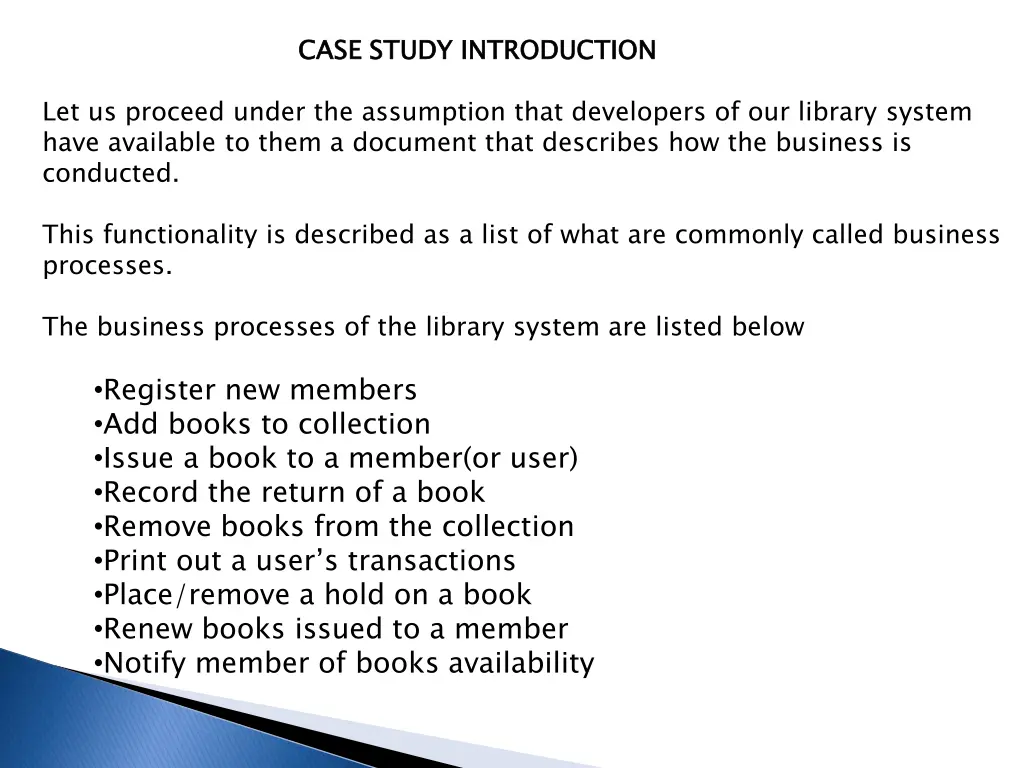
Optimizing Library System Business Processes for Efficiency
"Explore the functional requirements and use cases of a library system, focusing on key business processes like member registration, book management, and transaction recording. Enhance system efficiency with detailed analysis and proposed solutions."
Download Presentation

Please find below an Image/Link to download the presentation.
The content on the website is provided AS IS for your information and personal use only. It may not be sold, licensed, or shared on other websites without obtaining consent from the author. If you encounter any issues during the download, it is possible that the publisher has removed the file from their server.
You are allowed to download the files provided on this website for personal or commercial use, subject to the condition that they are used lawfully. All files are the property of their respective owners.
The content on the website is provided AS IS for your information and personal use only. It may not be sold, licensed, or shared on other websites without obtaining consent from the author.
E N D
Presentation Transcript
CASE STUDY INTRODUCTION CASE STUDY INTRODUCTION Let us proceed under the assumption that developers of our library system have available to them a document that describes how the business is conducted. This functionality is described as a list of what are commonly called business processes. The business processes of the library system are listed below Register new members Add books to collection Issue a book to a member(or user) Record the return of a book Remove books from the collection Print out a user s transactions Place/remove a hold on a book Renew books issued to a member Notify member of books availability
Functional requirement specification USE CASES OF A LIBRARY SYSTEM Functional requirement specification USE CASES OF A LIBRARY SYSTEM
7.1.4 Class Diagrams 7.1.4 Class Diagrams Hopefully, at this stage, we have come up with all the software classes. To review: 1. Library 2. Member List 3. Catalog 4. Member 5. Book 6. Hold 7. Transaction
7.1.5 User Interface As discussed earlier, our UI provides a menu with the following options: 1 Add a member 2 Add books 3 Issue books 4 Return books 5 Renew books 6 Remove books 7 Place a hold on a book 8 Remove a hold on a book 9 Process holds 10 Print a member s transactions on a given date 11 Save data for long-term storage 12 Retrieve data from storage 0 Exit 13 Help 7.1.5 User Interface
Implementation Implementation The addBooks method in UserInterface is shown below: public void addBooks() { Book result; do { String title = getToken("Enter book title"); String author = getToken("Enter author"); String bookID = getToken("Enter id"); result = library.addBook(title, author, bookID); if (result != null) { System.out.println(result); } else { System.out.println("Book could not be added"); } if (!yesOrNo("Add more books?")) { break; } } while (true); }
REMOVE THE HOLD REMOVE THE HOLD
Printing Transactions Printing Transactions
Issue Books Issue Books
Discussion and Further Reading Discussion and Further Reading Building a Commercially Acceptable System Building a Commercially Acceptable System Additional features can be easily added: Allowing for variability among kinds of books/members: Having a more sophisticated interface: Allowing remote access:
